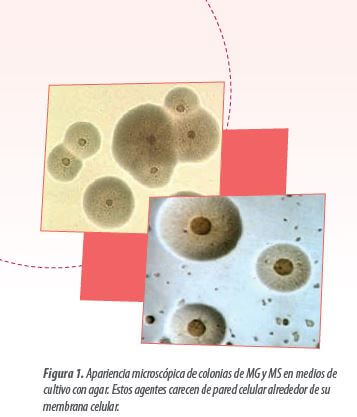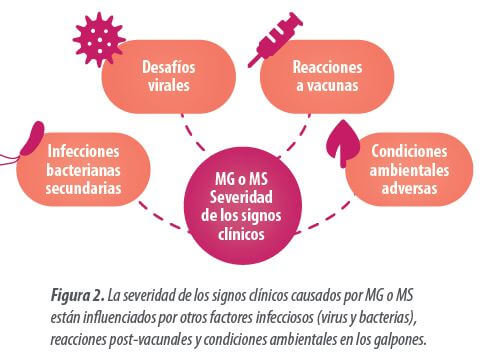To read more content about aviNews España ENG
To read more content about aviNews España ENG
Contenido disponible en:
Español (Spanish)
Mycoplasma gallisepticum (MG) and Mycoplasma synoviae (MS ) are bacteria lacking a cell wall that cause infections in domestic birds (Figure 1). These organisms continue to cause economic losses in the broiler industry worldwide. Cases complicated by other factors can lead to severe clinical problems or chronic respiratory disease (CRD).

Infections caused by MG can cause rales, cough, runny nose, conjunctivitis, exudates in the air sacs or aerosaculitis (Figure 3), and reductions in growth rates and feeding efficiency. In laying and breeder hens, they can cause drops in production and reductions in the total number of eggs per bird. Breeder cases can also result in high embryonic mortality with lesions in the air sacs.
There is variation in the degree of pathogenicity between MG and MS strains and consequently in the severity of clinical signs. Several factors (Figure 2) can exacerbate the severity of clinical signs:

Infections caused by pathogenic strains of MS in breeders are associated with production drops and reduced birth rates. The most common signs in chickens are inflammation (synovitis) of the tibio-tarsal joint (Figure 4), respiratory disease, delay in growth and increased discarded carcasses in the slaughterhouse due to lesions of aerosaculitis, septicemia-toxemia, peritonitis and swollen joints.
Recent cases of MS in breeders have caused dips in egg production, as well as abnormalities in eggshell quality. These abnormalities are located at the apex of the egg and are characterized by rough, thin and more translucent areas of the shell (Figure 5). These problems cause an increase in the number of cracked and broken eggs. These signs usually occur in MS-positive flocks and following outbreaks of infectious bronchitis virus with drops in egg production.

TRANSMISSION AND CONTROL
Control measures are based on preventing firstly the introduction and secondly, the transmission of MG or MS through both vertical (through the egg) and horizontal routes. Horizontal transmission occurs through aerosols, contact with infected birds, and indirect contact through mechanical transport by contaminated personnel, equipment, vehicles, and litter.
Other domestic birds and wild birds pose a risk for the introduction of MG. MS commonly causes infections in commercial egg-laying hens and flocks of pasture or backyard poultry. Humans can be mechanical carriers of avian mycoplasmas on the mucosa of the nose and in the hair for up to three days. Therefore, an interval of at least 48 hours after visiting infected birds, followed by showers at the entrance of the farm and changing clothes and footwear help prevent transmission.